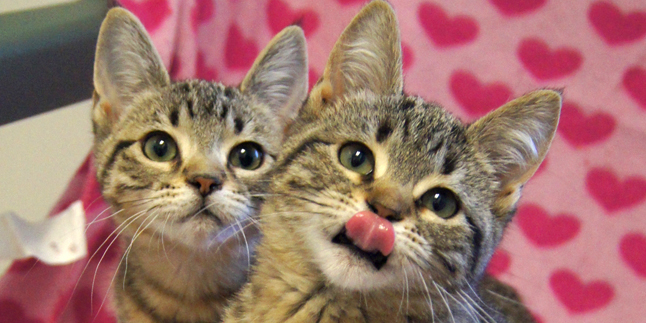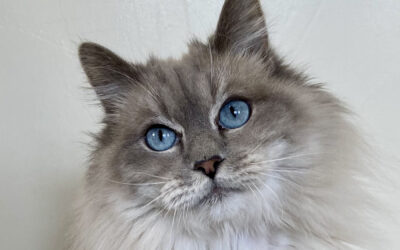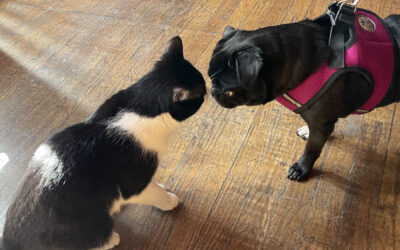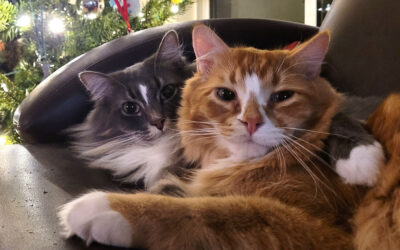You are what you eat. So are your cats.
 Our experience is that much illness can be prevented and/or healed with proper feline nutrition. This is not a substitute for proper medical care but a partner in your cat’s health.
Our experience is that much illness can be prevented and/or healed with proper feline nutrition. This is not a substitute for proper medical care but a partner in your cat’s health.
Cats are obligate carnivores. This means they must have meat to survive, unlike the omnivorous dog, who can survive on a wider variety of food.
Another difference is that cats have a relatively short digestive tract with a smaller stomach, compared to dogs (and humans). Cats’ livers are also lighter and much more simple than dogs, having evolved for lots of travel while hunting. Because they lack essential enzymes and amino acids, they simply don’t have the capacity to digest other food sources, like vegetable matter or fruit.
Your cat’s health depends on eating feline-appropriate ingredients in its food. The ideal diet for a cat is a mouse, which has around 55% protein and 23% fat. While there are sources for whole frozen mice to feed your cat, most people aren’t up to that task and rely on commercial or homemade cat food. It’s also just as important that your cat not be exposed to cat-inappropriate ingredients that may be toxic in the long run.
There is no complete consensus, either in the veterinary world or the pet consumer world, on whether to feed wet food, dry food, raw or homemade food. However, more and more veterinarians are recommending wet food over dry.
Cats evolved as desert animals who got most of the moisture they needed from their prey rather than water sources. If their food is dry, they may not drink enough water to compensate. Adding at least one serving of moist food to your cats’ diet can help prevent later disease.
As previous pet food recalls showed us, even the most premium pet food brands have been known to put questionable ingredients in their food. It’s up to us to become well-informed consumers and choose the best food to keep our cats and kittens healthy.
We’ve drawn on the best research we can find for this article and offer these parameters for what to look for in your cat’s food and what to avoid.
PROTEIN
According to the AAFCO, adult cats can survive on 26% protein, while kittens and lactating queens need 30%. However, a mouse is around 55% protein, so a higher protein content will enable them to thrive, not just survive.
While the AAFCO definition of “by-product” can contain good ingredients such as clean internal organs, pet food manufacturers are also allowed to include everything from sick slaughterhouse animals to euthanized animals to expired junk food. Since there is no consistency to the mix, it’s best to avoid this source.
Look for whole sources of protein, like whole chicken, turkey, eggs or fish. The best sources are from animals the cat could conceivably kill, with amino acid ratios appropriate to feline kidneys. This means chickens, turkeys and other small birds with occasional eggs and fish. “Meal” means the fat and water of the protein have been removed and is usually a satisfactory source of protein, since it’s more concentrated, but make sure the animal is specified.
Avoid non-specific meat, especially by-products as the initial ingredient as that can legally contain any form of animal matter (i.e., skin, fur, organs, etc.) and residual matter from processing which are unhealthy choices.
FAT
While the AAFCO puts minimum fat needs at 9%, a mouse would be around 23%. Around 15% fat is a good compromise. The fat source should be from a specific animal and not from vegetable sources which cats can’t convert to an appropriate fatty acid.
GRAINS/CARBOHYDRATES
A cat’s natural prey like the mouse would be around 3% carbohydrates. Cats actually have little metabolic need for carbohydrates and no way to convert carbs to energy, the way dogs and humans can. Grains are added to dry kibble to make it easier to handle for humans. The most appropriate grain for cats, according to research, is rice, and the most appropriate form for rice is rice bran. It should come after the protein sources in the list of ingredients. Wheat, soy and corn can be allergens and have a high chance of being genetically modified (GMO). They have not been studied for their affects on cats and should be avoided. Avoid gluten as an ingredient as it’s not digestible and has been known to be a serious contaminant.
FIBER
Up to 90% of the immune system response lies in the intestine. Fiber plays a huge role in making sure the intestine is healthy. Rice bran and beet fiber have proven to be good sources of fiber for felines in that they provide the fermentability for good bacteria as well as not lowering the digestibility of the rest of the food.
Other fibers, like cellulose, oat, peanut, psyllium, soy, citrus, FOS and peas have become common but are less studied and not as digestible as rice and beet.
VITAMINS & MINERALS
Cats need most of the same vitamins and minerals that dogs do, with the following exceptions. Cats need more Vitamin A than dogs because they can’t convert beta carotene. They also need twice the amount of B Vitamins: (Thiamine, Riboflavin, Pyridoxine, Pantothenic Acid, Niacin and B-12). Most commercially prepared diets contain the recommended amounts of vitamins and minerals for cats and it can be dangerous to supplement past minimum requirements.
VEGETABLES & FRUITS
Many cat foods, especially higher-end ones, are marketed toward the human, not the cat. This leads to unresearched additives like tomatoes, blueberries, cranberries, potatoes, carrots, spinach, apples, zucchini…the list goes on. In addition, avocados have been found to be toxic to cats.
Cats suffer with less research funding than dogs have, so many of these ingredients have not been proven to be safe. Again, a feline-appropriate diet would not contain more than small amounts of carbohydrates and most cats in the wild do not forage for vegetables or fruit. In general, it’s best to avoid cat food with extra vegetables or fruit.
PRESERVATIVES
Mixed tocopherols (Vitamin E) have been proven to be safe and effective preservatives in cat and dog food. Some manufacturers still add cheaper and more deadly preservatives like ethoxyquin and BHA/BHT to their formulas, so try to avoid them.
THICKENERS
This is an odd category, but must be included for canned cat food, since almost all brands have some in them. Try to avoid food with carrageenan, which is known to produce intestinal lesions, ulcerations and tumors in experimental animals–and guar gum, which has been shown to decrease the digestibility of protein in cat food.
FOOD COLORING
Cats can only see minor variations in color, so any bright colors in food are put there for the humans, not for the food. No food coloring has proven to be safe for felines, so if your cat’s food isn’t meat colored, avoid it.
REFERENCES
ASPCA (2011) Toxic and non-toxic plants. Retrieved from http://www.aspca.org/pet-care/poison-control/plants/
Association of American Feed Control Officials, 2005-2010, Official publication.
Becker, K. (2011) What dangerous byproducts lurk in cat food? Retrieved from http://healthypets.mercola.com/sites/healthypets/archive/2009/07/21/proper-nutrition-for-your-cats.aspx
Berg, J. (June, 2012) Catnip: the newsletter for caring cat owners: Settling the dry-versus-wet-food debate, p. 7.
Board on Agriculture (1986) Nutrient Requirements of Cats, Revised Edition. Retrieved from: http://www.nap.edu/openbook.php?record_id=910&page=34
Carciofi, A. C. and Brunetto, M. A. Nutritional Management of the Most Common Digestive Diseases in Dogs and Cats Retrieved from http://tinyurl.com/catdigestivediseases
Contreras, S. (2007) Meniodone (vitamin K3). Retrieved from http://www.dogfoodproject.com/index.php?page=menadione
Creighton, P. (2007) Pet food pitfalls. Retrieved from http://petfoodpitfalls.blogspot.com/
Dierenfeld, E. S., Alcorn, H. L., Jacobsen, K. L. (2002) Nutrient composition of whole vertebrate prey (excluding fish) fed in zoos. Retrieved from http://tinyurl.com/preynutrition
Erickson, P. (2010) Feline constipation: gut bacteria and fiber. Retrieved from http://www.felineconstipation.org/gutbacteriaandfi.html
European Food Safety Authority (EFSA) (2012) EFSA Journal: Statement on the safety and efficacy of the product ‘Rosemary extract liquid of natural origin’ as a technological feed additive for dogs and cats. Retrieved from: http://www.efsa.europa.eu/de/efsajournal/pub/2526.htm
Fekete, S. G., Huller, I., Andresofszky, E., Kelemen, F. (2004) Journal of Animal Physiology and Animal Nutrition, Effect of different fibre types on the digestibility of nutrients in cats
Gavin, R. (2005) The Boston Globe: Growers’ pet project. Retrieved from:
http://www.boston.com/ae/food/articles/2005/04/21/growers_pet_project/
Harper, E. J., and C. Siever-Kelly. (1997) Recent Advances in Animal Nutrition in Australia, The effect of fibre on nutrient availability in cats of different ages.
Kovalkovicova, N., Sutiakova, I. Pistl, J. and Sutiak, V. (2009) Interdisciplinary Toxicology: Some food toxic for pets. Retrieved from http://www.ncbi.nlm.nih.gov/pmc/articles/PMC2984110/?tool=pubmed
Liquorman, N. (2012) Pet food neurotoxin: rosemary extract & seizures. Retrieved from: http://www.thedogpress.com/DogFood/Rosemary-Neurotoxin-10032_Liquorman.asp
Max’s House Animal Rescue (2011) Feline nutrition. Retrieved from http://maxshouse.com/feline_nutrition.htm
Siegal, Mordecai (1997) The Cornell book of cats: the comprehensive and authoritative medical reference for every cat and kitten, pp. 258-259.
Sunvold, G. D., Titgemeyer, E. C., Bourquin, L. D., Fahey, G. C., Reinhart, G. A., (1994) Journal of Nutrition: Fermentability of Selected Fibrous Substrates by Cat Fecal Microflora
Thixton, S. (2009) What ‘kind’ of protein is your pet eating? Retrieved from http://www.truthaboutpetfood.com/articles/what-%E2%80%98kind%E2%80%99-of-protein-is-your-pet-eating.html
Thixton, S. (2012) Carrageenan: just don’t do it. Retrieved from: http://www.truthaboutpetfood.com/articles/carrageenan-just-dont-do-it.html
Tobacman, J. (Oct. 2001) Environmental Health Perspectives: Review of harmful gastrointestinal effects of carrageenan in animal experiments. Retrieved from http://ehp03.niehs.nih.gov/article/fetchArticle.action?articleURI=info:doi/10.1289/ehp.01109983
Yarnall, C., & Hovfe, J. (2009) The complete guide to holistic cat care.




